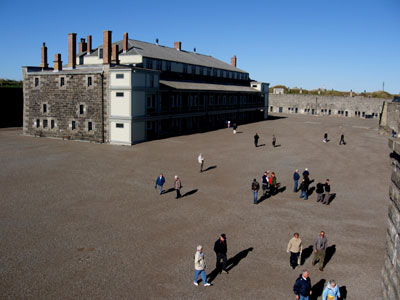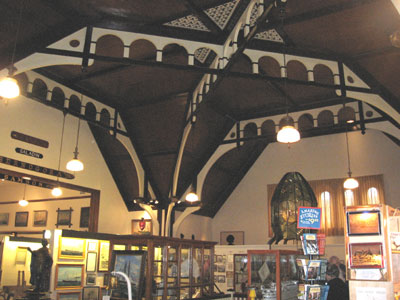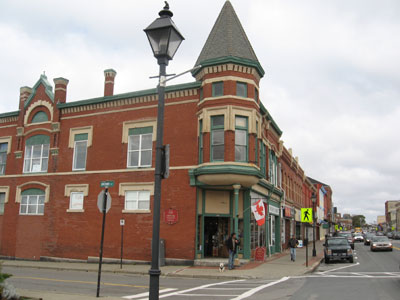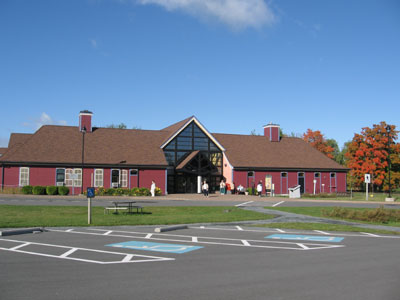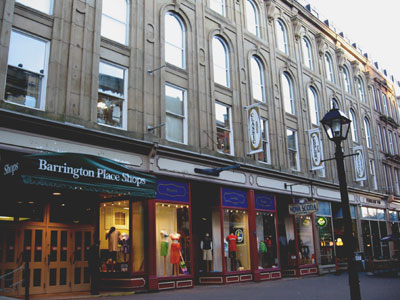Our final stop on this city tour was the Fairview Cemetery which is the largest burial ground of Titanic victims in the world. Allen took us to a corner of the cemetery where there were three lines of white gravestones, all arranged in lines of different curvatures that symbolic reflect the shape of an ocean liner on the top deck, the waterline and under water. Allen explained that the gravestones were erected by the White Star Line, the company that owned the Titanic.
The gravestones are very small and simple, and Allen added if people wanted a larger gravestone they would have had to pay extra for a larger version. He pointed out the grave of the “Unknown Child”, the youngest victim recovered who remained unidentified. The headstone reads “Erected to the memory of an unknown child whose remains were recovered after the disaster of the “Titanic” April 15th 1912”. Allen recounted various speculations that surfaced over the years of who this unknown child might have been. In 2002 finally it was determined through DNA evidence that the unknown child was actually Eino Viljami Panula of Finland whose mother and four brothers had also died in this disaster.

The grave of the unknown child
Allen also mentioned that the wreckage of the Titanic was discovered in 1985 by an American-French expedition. The wreck had broken into two pieces on the ocean floor, with the stern section lying about 600 m from the bow section and facing in the opposite direction. What was really significant was that when scientists compared the geographical orientation of one of the wrecks with the orientation of the graves at the Fairview Cemetery, they were positioned with almost the same geographical orientation. Hearing this sent shivers up my spine, when I realized that the wreck of the world’s most famous shipping disaster could coincide so accurately with the positioning of the cemetery holding its greatest number of victims. Things like these are almost too much of a coincidence.

Exhibit about the 1917 Halifax Explosion in the Maritime Museum
On our way back from the cemetery, Allen enlightened us about another Halifax disaster: the 1917 Halifax Explosion – the largest man-made non-nuclear explosion in human history which occurred on December 6, 1917. During the First World War many ships used Halifax as a strategic port for their ocean voyages to Europe to partake in the War. On this fateful day many ships were lined up in the Bedford Basin to leave the harbour to start the voyage while other ships were entering the harbour from the other direction.

Halifax 1917: “Piles of coffins are already at the wharf”
The Mont-Blanc, a French freighter arrived at the Halifax harbour, waiting to be let into the port. Fatefully, it was carrying thousands of tons of explosives including benzol, nitrocellulose and TNT. A Norwegian ship, the Imo, was trying to depart through the right harbour channel, but another ship was blocking its way, so the Imo veered to the left, directly into the path of the Mont Blanc. Both ships refused to yield, leading to a collision at about 8:45 am that ignited the benzene that was stored on deck of the Mont Blanc. With the fire out of control and knowing their cargo, the ship’s crew immediately abandoned the ship while hundreds of people were drawn to the harbour to watch the fire. At about 9:04 am the Mont Blanc finally exploded, instantly vapourizing the ship in a fireball that rose over one mile into the air. The force of the explosion triggered a tsunami that reached up to 18 meters above the high water mark. The explosion could be heard as far away as Charlottetown, Prince Edward Island, about 175 kilometers away. Not a pane of glass was left intact in the city and 6,000 people became homeless.

The 1917 Halifax explosion
The pressure wave from the blast could be felt as far away as Cape Breton Island, about 205 km east of Halifax. A large portion of Richmond, Halifax and Dartmouth were leveled to the ground, and the death toll reached 1900 people. Thousands more were injured, many seriously, and countless people were blinded due to the glass shrapnel that was propelled through the air.
Allen also mentioned the story of a local hero: Vince Coleman, a dispatcher for the Intercolonial Railway. Minutes before the explosion he telegraphed two trains that were bound for Halifax, and told them to stop at a safe distance from this area. Vince himself was killed in the blast, but were it not for him, several hundreds more could have died in the explosion.

Maritime mural in Halifax
The reaction in the aftermath was swift. Communities from all over North America pitched in and sent aid, especially tents, blankets and supplies to Halifax. Boston, in particular, was extremely generous and sent an entire train of supplies and medical personnel to help the victims of this enormous explosion. As a result, every year at Christmas, Nova Scotia donates a large Christmas tree to the City of Boston to thank and remember Boston’s help in this major time of need.
My trolley tour provided by the Company with the Kilts had come to an end. But as we arrived right in front of the Maritime Museum of the Atlantic, I decided to make a quick stop in this museum since among many other things, it features two major exhibits: one about the Titanic Disaster and another one about the Halifax Explosion. I decided to educate myself more about these two significant historic events. The exhibit about the Halifax Explosion features historical photographs, newspaper clippings and explanations about this enormous disaster.

Schematic diagram of the Titanic
The Titanic Exhibit upstairs actually features dozens of photographs and 20 authentic artifacts from the Titanic, first and foremost the only known intact Titanic deck chair in the world. This chair had actually been given to the minister who had performed so many of the burials at sea and was donated by one of his grandchildren to the Maritime Museum of the Atlantic.
Another exhibit features the Shoes of Titanic’s Unknown Child which feature the pencil inscription: “SS Titanic victim boots worn by only baby drowned”. One poignant display illustrates that fact that passenger class made a huge difference in the survival rate of passengers. For example less than 4% of first class female passengers perished, while around 12% of second class female passengers died and more than 54% of third class female passenger did not survive.
I did not have time to explore the rest of the Maritime Museum of the Atlantic which features a whole host of additional interesting exhibits such as the Days of Sail, Shipwreck Treasures and Age of Steam Gallery, to mention just a few. Now it was time for a quick lunch and then my next stop at Pier 21, Canada’s immigration museum and a National Historic Site, and the entry point form more than a million New Canadians between 1928 and 1971.
